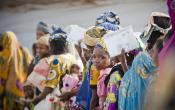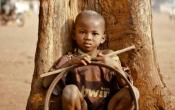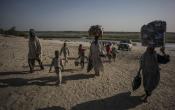Chad
Operation: Chad
Location
{"longitude":19,"latitude":15,"zoom_level":0}
Latest update of camps and office locations 13 Jan 2016. By clicking on the icons on the map, additional information is displayed.
Key Figures
| 2015 end-year results | |
| 1,300 | files of people of concern were submitted for resettlement |
| 7,800 | refugee children received birth certificates |
| 54,600 | children were enrolled in primary school |
| 73,000 | households had adequate dwellings |
| 45,100 | people of concern received support for their agricultural, livestock and fishery activities |
| 2016 planning figures | |
| 37,798 | malnourished children (baseline) |
| 417,865 | people of concern enjoying freedom of movement (baseline) |
| 79,426 | registered refugee children targeted to be enrolled in primary education |
| 135,625 | people of concern targeted to receive long-term/permanent shelter |
Latest Updates and Related Links
People of Concern
6%
Decrease in
2015
2015
| 2015 | 474,478 |
| 2014 | 505,067 |
| 2013 | 454,967 |

[["Refugees",369540],["Asylum-seekers",2898],["IDPs",51999],["Returned refugees",41],["Others of concern",50000]]
Loading ...
Budgets and Expenditure for Chad
< Back
2015
{"categories":[2012,2013,2014,2015,2016],"budget":[177.07778363,200.85624928,227.01880633,171.27878662,162.72600883],"expenditure":[89.29247125,89.65632862,84.18710953,75.37343665,null]}
{"categories":[2012,2013,2014,2015,2016],"p1":[159.52616057,188.0295658,227.01880633,168.80272862,160.1774915],"p2":[null,null,null,1.591058,0.91141933],"p3":[null,null,null,0.885,null],"p4":[17.55162306,12.82668348,null,null,1.637098]}
{"categories":[2012,2013,2014,2015,2016],"p1":[82.72209916,87.37685405,84.18710953,73.95915008,null],"p2":[null,null,null,0.60820855,null],"p3":[null,null,null,0.80607802,null],"p4":[6.57037209,2.27947457,null,null,null]}
Loading ...
CHOOSE A YEAR
- 2014
- 2015
- 2016
Working environment
- In 2015, increased attacks by armed insurgents led to the declaration of a state of emergency in the Lake Region.
- Falling oil prices, blocked commercial routes and the cost of fighting against the insurgency led to Chad’s inability to fulfil its engagements toward the humanitarian response.
- The delivery of assistance in remote areas was difficult and costly.
- Implementing the Strategy on Alternative to Camps was hampered in the east, owing to restrictions on refugee movement outside of camps.
- The inclusion of refugees in national systems, especially education and health, remained challenging.
Population trends
- In 2015, the results of a biometric registration exercise showed that there were 20 per cent less persons of concern than in previous years in Chad. The total year-end number of persons of concern stood at some 372,000. Over 6,000 persons of concern (51% women, 48% men) who fled Nigeria owing to armed insurgency settled in the Lake Region.
Achievements and impact
- The verification and biometric registration of all refugees was completed.
- The Dar es Salam camp was constructed for Nigerian refugees.
- Over 19,000 persons of concern received emergency assistance, while some 6,000 individuals in the Lake Region were provided with emergency shelter.
- The distribution of targeted food assistance was extended from 2 to 9 camps.
- Water coverage increased by an average of 8 litres per person per day, amounting to nearly 48 litres per person per day in the south.
- Mortality rates, including among infants under the age of 5, were within the acceptable standards for an emergency.
- Of the 1,500 survivors of sexual and gender-based violence (SGBV) identified, 100 per cent received assistance.
Unmet needs
- Nutrition: In 5 out of 17 camps, the global acute malnutrition rate did not meet acceptable standards. Moreover, the prevalence of anemia in children under the age of 5 rose to 65 per cent in some of these camps.
- Energy: The provision of alternative energy sources was insufficient to replace firewood. As a result, the risk of SGBV that persons of concern face when collecting firewood could not be fully addressed.
- Documentation: While over 18,000 Chadians repatriated, none received identity cards.
- WASH: Only 1 out of the 85 planned water points was constructed, while less than a third of 9,700 planned family latrines were built.
Working environment
With ongoing conflict and violence in several neighbouring countries, notably the Central African Republic (CAR), Nigeria and South Sudan, Chad’s refugee population is likely to increase in 2015.The needs of CAR refugees for protection and assistance will remain significant in 2015.
UNHCR enjoys excellent working relations with the Chadian Government. The organization will continue to assist the Government in issuing national identity cards to second and third-generation Chadian returnees without family links, who are at risk of statelessness.
On 31 July, more than 1,000 Nigerian asylum-seekers arrived on the island of Choua in the Lake Chad region, some 4 kilometres from the border crossing. Chad was already hosting more than 1,500 Nigerian refugees (488 families). A supplementary appeal was launched to cover the cost of responding to these new emergency needs. Given the unpredictability of incidents and violence in Nigeria, UNHCR is planning for further influxes in 2015.
The Government has granted refugees and returnees access to arable land for agricultural production, contributing to their self-reliance, as well as social and economic integration strategies. The Government is supporting efforts to seek alternatives to camps, allowing refugees to settle in host communities and access basic community services.
Needs and strategies
In 2015, UNHCR will continue to provide basic services, such as nutrition, health, WASH, education, and documentation, to refugees and other people of concern; and work with all partners to place protection considerations at the core of all interventions.Facilitating livelihood activities, finding alternatives to camps, acquiring land and promoting freedom of movement will remain key priorities in a bid to strengthen self-reliance. UNHCR will work with the Government and development partners to progressively integrate refugees into existing programmes and other relevant initiatives. Non-agricultural livelihoods are limited, with only 2 per cent of refugees expected to access micro-finance services by the end of 2015.
Education, sexual and gender-based violence (SGBV), and child protection will be priorities. As part of a multiyear strategy, the organization will establish measures to: identify and monitor children at risk; carry out best interest determination; provide support and quality services to SGBV survivors; prevent exploitation and violence, especially for refugee girls; and ensure the smooth transition from the Sudanese to the Chadian curriculum. Funding shortfalls mean support for access to secondary schools and vocational training will be limited, with only half of the targeted secondary-age population in school. To support SGBV survivors, UNHCR will implement safety and security measures, provide material assistance, build local support capacity, and run awareness-raising activities.
The conflict in the CAR and ongoing intra-community clashes in Darfur make voluntary repatriation in 2015 unlikely. With limited prospects for local integration, resettlement remains the only viable durable solution. UNHCR will prepare refugees for durable solutions by facilitating livelihood opportunities, strengthening self-reliance and promoting peaceful coexistence with local communities. It will also support efforts to bridge the gap in living standards between refugees and host communities. Alternatives to camps will be explored, and all efforts made to facilitate refugees’ freedom of movement.
Existing national structures, such as water, sanitation and hygiene facilities, health centres and schools, will be strengthened, and relevant line ministries’ capacity to run and maintain such services will be enhanced. Important partnerships with development actors and links to national development plans will be nurtured, to increase the sustainability of interventions.
The option for new refugees to stay in communities instead of camps will be pursued. UNHCR will provide technical expertise to support the Government in complying with international commitments.
The Office will work to remove barriers to accessing documentation for some 113,000 Chadian returnees. It will also endeavour to uphold good quality registration, and provide identification cards to all refugees, gradually introducing biometrics in the course of 2015. In addition, as a new law on civil status was adopted in 2013, it is likely that by 2017, birth certificates will be automatically issued to refugee children in eastern Chad, and the backlog of Sudanese refugees without documents will be addressed.
UNHCR will assist the authorities in issuing identification documents to Chadian returnees to prevent them becoming stateless. Some 36,000 Chadians without links will have been documented by the end of 2014, and another 20,000 in 2015.





